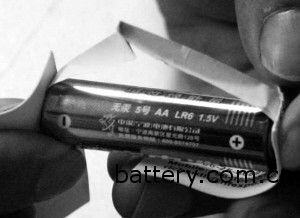Onlookers: Can the battery really burn with chewing gum paper?
Recently, a moving picture with a battery to fire has caused great repercussions in the network. In the figure, the operator peels off a piece of tin foil wrapped in chewing gum and cuts it into small strips with scissors. After a pinch on the battery poles, the tin foil burns quickly. However, this method is not easy to implement. Moreover, because of the large amount of heat during operation, it is best to use this person who uses the fire in the wild to avoid fire! Although the text of this animation only has a formula of "battery + chewing gum tin foil = fire tool", it still shocked many netizens. Some netizens shouted incredible, saying that this can be used as a fire tool in the wild; some netizens think that this experiment is not real, just a hype. Is it easy to get a battery and chewing gum tin foil to ignite a flame? What is the scientific principle? The reporter decided to experiment with this method to verify this method. [Preparation Phase] The reporter prepared three different voltage and model batteries, all of which are disposable and non-rechargeable. They are a 1.5 volt No. 5 battery, a 1.5 volt No. 1 battery, and a 9 volt 6LR 61 battery. The reporter also prepared a number of tin strips of varying widths, thicknesses, and lengths of about 7 cm. [Experimental stage] Experiment 1: The reporter folded the tin foil with a length of 7cm and a width of 1cm in half, so that the side covered with tin was exposed, folded again from it and gently folded a "tip" of about 0.5cm, then the tin strip One section rests on the positive pole of a No. 5 battery, and then gently leans the other end against the negative pole. At this time, you can feel that the battery is hot, and the "tip" that has just been folded in the middle also has a white smoke coming out. You can also see the black marks after burning, but the tin foil does not burn as intensely as in the picture. . Experiment 2: Why does the same experimental condition tin foil not burn? Is the animation on the Internet fake? The reporter carefully looked at the animation and found that after the foil strip was folded, it was necessary to cut it with scissors. The protruding part of the shape becomes sharp. So the reporter still used the No. 5 battery and the same tin strip as the experiment, but cut a part with the scissors protruding from the tin strip. The two ends of the tin foil are again placed on the two poles of the battery. After 1 second, the middle of the tin foil starts to ignite, and the entire tin strip starts to burn, which is the same as in the network diagram. Experiment 3: Since the 1.5 volt 5th battery can realize the tin foil burning, can other battery types be used? The reporter found the 1.5 volt battery No. 1 and experimented according to the method just now, but this time there is no white smoke. . The experimental response of the 9 volt 6LR61 battery is exactly the same as that of the No. 1 battery, without any signs of burning. in conclusion The conclusion we have obtained is obviously different from the experimental results of netizens. In the second experiment, the tin foil burned quickly, but in the experiment, the tin foil was only smoked and not burned, while the third experiment did not have any combustion reaction. It seems that to reach the battery on the Internet + chewing gum tin foil = fire tools also need certain experimental conditions, there are requirements for experimental materials. Tin foil width and voltage are important Why is the tin foil burning? Zhou Wei, a bachelor of physics at Nanjing Normal University, said that this is actually a very simple truth. "This experiment is theoretically feasible, but in practice, there is a requirement for the width of the tin strip and the battery voltage. It is not a simple material." Because the tin foil is electrically conductive, when the tin foil is at both ends and the battery When the two poles are connected, a current loop is formed. In the case of the same voltage, since the voltage is equal to the current multiplied by the resistance, the smaller the resistance, the larger the current, that is, the cross-sectional area of ​​the tin foil becomes smaller, which causes the current to change. The temperature rises and then burns. Therefore, the narrowest part of the tin strip will burn. Villa Elevator,Home Elevator,Lift Parts FJZY Elevator Co., Ltd. , http://www.dz-elevator.com